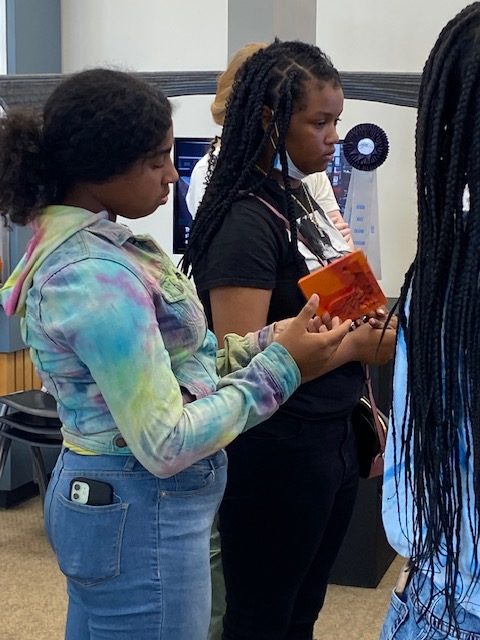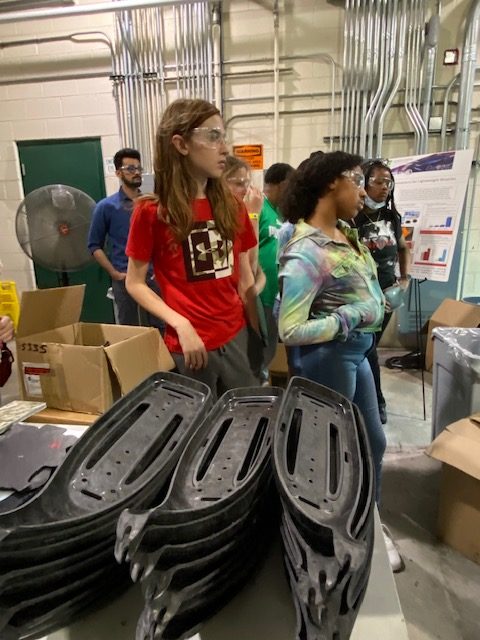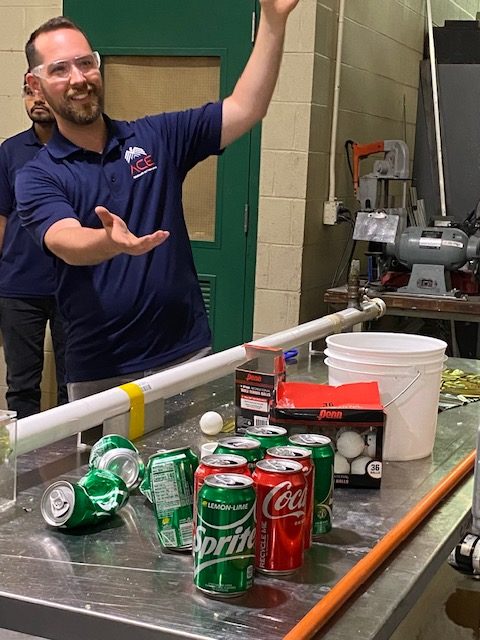
June 8, 2022 — It always starts with a need. A problem in search of a solution. That’s how a new IACMI-led STEM program called SkillCrafters hooks middle and high school students and proves to them their ideas matter. A frisbee that bounces back, more affordable prosthetics, a drone that delivers food to the homeless, a versatile hairbrush, and more durable shoes for Africa are all ideas using composites that seventh graders are working on to address needs around the world.
“SkillCrafters is allowing our kids to reach those higher order thinking skills that we talk about but don’t always provide opportunities for: like imagining, designing, creating, developing,” says Angela Anderson, librarian and advisory teacher at Vine Middle Magnet School in Knoxville. “They’re given parameters but then allowed to run with their ideas and connect with their world. We don’t typically give enough opportunities for that during the school day.”

Joannie Harmon, Workforce Director for the Institute for Advanced Composites Manufacturing Innovation (IACMI) adds, “We’re thrilled to be engaging in STEM educational programs which broaden opportunities in schools and increases awareness of career pathways in advanced composites at an earlier age in a way that makes STEM fun. SkillCrafters helps students gain confidence in their abilities and gives them motivation to use science and math in a practical, real-world application associated with a project that is meaningful to them.”

One of those students, Kemonta has been dreaming about the “Helimicopter” for years since he started prototyping it in fifth grade. It is an automated drone that delivers food directly to the homeless in cities. Motivated by the large number of homeless people in California (160,000—far more than any other state), he and his group are working on ways to safely deliver refrigerated foods like fresh meats, fruits, and vegetables. “I want to make sure they get chicken because that’s my favorite. We need to give them good food they really want to eat. Having a drone that doesn’t have to worry about traffic will be good in places like LA.” Helping him develop his idea using composite materials, which could make the Helimicopter lighter and stronger, is what makes SkillCrafters unique.
SkillCrafters is a program developed by IACMI and sponsored through the Department of Defense Office of Naval Research and NextFlex. The goal is to engage and challenge students in the K-12 space to have an increased awareness of advanced composites materials, their processes, and how they impact our world today. Also, SkillCrafters is designed to be a learning experience that is inclusive of all students to nurture a more diverse workforce for the future of advanced manufacturing education and careers opportunities. In addition to classroom curriculum and videos, students take a field trip to educational and industry specialists in advanced manufacturing.



The group from Vine visited the Fibers and Composites Manufacturing Facility on the campus of the University of Tennessee, Knoxville (UTK) just two miles from their school. They saw demonstrations of additive manufacturing like 3D printing and subtractive techniques being used to manufacture parts for an electric bicycle. Anderson shares, “To see real scientists creating real products is a whole different level. And to know this is happening right down the road–in a space they could be working in one day–is huge for our kids.”
Laschinski Emerson with A-1 Learning Connections, who’s partnered with IACMI to implement SkillCrafters, agrees these learning opportunities are vital for students. She adds, “I want you to see their passion–the time, effort, and energy they’ve put into researching a problem and presenting a solution. Many of them are wanting to manufacture a product and are looking for ways to do that.”

Each SkillCrafters program concludes with students pitching their presentations Shark Tank style to industry experts. Emma Betters, an R&D scientist at Oak Ridge National Laboratory and Ph.D. student at UTK, was one of those experts giving feedback to students. “As an engineer, it’s great to see a bunch of 12-year-olds thinking about materials and how to apply them. Even if they don’t become engineers, learning about materials makes you a better consumer. They’re learning how much something should cost and how supply chains can impact when or even if products are made.”
Learning that prosthetic limbs cost between $20,000 and $100,000, budding entrepreneurs Stella, Jared, and Zoe have been exploring how using composites could lower costs. Jared says, “I think being able to learn how to upgrade something that already exists to make it cheaper and more accessible was really cool.” Stella adds, “It made me think this is a career I could do, a career I hadn’t considered before.”
Regardless of where their careers take them, SkillCrafters has been a chance for them to look beyond themselves and seek ways to help others. When Cora learned how labor intensive the basic task of securing clean water is for many in Africa, she was motivated to design a better shoe. “We can’t just send them cheap flip flops, and they probably don’t want sneakers. Composite sandals could be lighter and last longer.” Betters and fellow Ph.D. student George Chahine suggest using recycled content to boost its sustainability value, a component that is becoming a driving factor in manufacturing. Having grown up in Lebanon, Chahine applauds students looking beyond their own needs to help those in other countries. “By honing their presentation skills, they’ll be able to communicate needs and solutions that could have international impact.”
“In all honesty,” Anderson reveals, “There was grumbling about starting this so late in the school year. They were tired. We were tired. And some students didn’t feel science was their thing. But once they got into it and were allowed to use their creativity and do their own research, there was a lot of buy-in. Some positive peer pressure trickled down to the groups that weren’t quite as engaged. I am so proud of their tremendous growth in a short time.”

The first SkillCrafters program, now complete, is serving as a springboard for programs aimed at middle and high school students in Knoxville and Bristol, TN this summer and fall with the help of partners like Junior Achievement, Project Grad, and local school systems. Given its recent success, Harmon concludes, “We’re hoping that within a year, 600 students will have completed SkillCrafters. We’re off to a strong start.”
